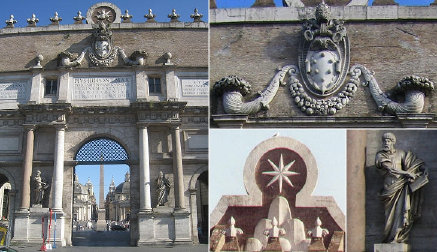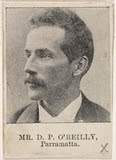
Contact

Home
THE MARBLE MAN
The Sydney Morning Herald (NSW)
Date: June 5, 1889
Page Number: 9
TO THE EDITOR OF THE HERALD.
Sir,--Mr. Oscar Meyer's theory as to the composition of "the marble man" is, to say the least, ingenious; but it is only a theory, after all. His opinion is much more at variance than mine with that of the Government Geological Surveyor. I, at least, agree with the Geologist that it is a natural calcareous formation, whereas Mr. Meyer says it is purely artificial ; though it does seem strange that he can advance any opinion at all, considering his admission that he has not been afforded sufficient opportunity for examining the specimen. Mr. M ever proceeds to give what he calls "a prescription" for the chemical manufacture of such articles. He speaks of acids, but fails to mention the names of the acids employed. He gives us the name of one ingredient (alabaster) ; why not include the names of all the others ? Is there, for instance, hydrochloric, hydro-fluosilicic, or carbonic acid, in the mixture? I am quite sure there should be at least a goodly supply of the latter to make the present specimen. By what unaccountable means can Mr. Meyer convert the sulphate of calcium in his "finest alabaster plaster" into carbonate without dissolving away his cast ? He will also have to satisfy us, before we can place credence in his theory, how he can successfully imitate the marble graining seen on the specimen, and also certain stripe and metallic deposits, as well as that "hair" or flaw which Signor del Vascova speaks of in his letter to-day, none of those evidences of natural formation being seen in alabaster. Lastly, he will have to produce, in his imitation, such a condition of molecular arrangement as will give, on striking the article, the true ring of marble. Unless my perception of the quality of sound is very much blunted, I have recognised that true ring on striking the present specimen. So has the gentleman whose name I have just mentioned - a sculptor of 40 years' practical experience, whose opinion is certainly worth having.
I am aware there is, or was, an establishment belonging to the Marquis of Campana, in the Porta del Popolo in Rome, in which alabaster imitation-marble images were made, but sold and easily recognised as imitations only. For all I know, the trade in this Tuscan Volterra alabaster may be elsewhere carried on ; but certainly the man who could introduce into the industry such improvements as would give the natural stripe graining, and unmistakable ring of the real stone, in such a manner as to deceive even those who have worked at marble for nearly half a century, deserves to make his fortune.
I am., &c,
CHARLES W. M'CARTHY,
June 4. M.D., F.R.C.S., Irel.



Porta del Popolo:
THE MARBLE MAN
The Sydney Morning Herald (NSW)
Date: June 5, 1889
Page Number: 9
TO THE EDITOR OF THE HERALD.
Sir, - May I suggest that the "marble man" is only one more instance of those terrible blunders so often committed at funerals. What is easier to suppose than that there was once a fashionable funeral at Orange - lots of undertakers --even more refreshments ? Result: They buried the cherub by mistake.
I am, &c., DOWELL O'REILLY.

O'Reilly, Dowell Philip (1865–1923)
Cultural Heritage: Manx
Religious Influence: Anglican
Poet, school teacher, cricketer, and 2nd lieutentant in the Parramatta Volunteer Rifles (colonial militia).


"THE PETRIFIED MAN."
The Brisbane Courier (Qld.)
Date: June 6, 1889
Page Number: 7
"The petrified human body or ancient sculpture," as the handbills distributed at the door of the Park-street shop, where the specimen is "on show," describe it, continues (says the Sydney Daily Telegraph) to attract large numbers of curious persons. Indeed, it may not be too much to say that this singular exhibition has, within the last few days, become one of the sights of the city. You are invited by the advertisement to "come and judge for yourselves,"- that is, to examine the relic as closely as you like, and then say whether you are inclined to agree with Mr. Wilkinson, the geological surveyor, and the scientists who accompanied him on his visit of inspection, who insist that the "body'' is nothing but a block of ordinary marble, chiselled by some ingenious hand into a semblance of "human form divine," or with Dr. M'Carthy and other gentlemen who maintain that it is in reality a petrified man. The writer saw the specimen for the first time after reading Mr. Wilkinson's official report. He went prepared to scoff, and if the truth must be told, remained, in a sense, to pray. It certainly is a most extraordinary object, and the very fact that it is capable of dividing the opinion of scientists leaves a lay-man, prepared to bring nothing more specific than common-sense to bear upon it, utterly at sea. To be sure, one would imagine that it was a simple matter with a block of marble before him to say whether it had ever been of human organisation. There it lies, stretched out on a plain deal box like a pauper's coffin. It is not wrapped up in spiced cloths like a Bloomsbury mummy ; it has practically no encrustation of mineral about it ; what the visitor sees is the form of a dead man, with his arms cut off at the shoulders, and an enormously large head, but otherwise perfect, every limb as clean cut as possible, the ribs indicated plainly, the toe-nails as distinct as possible, and a bit of the bone sticking out where the arms have been cut off. And as one gazes upon it it becomes more difficult to believe that it is an imitation without becoming very much easier to believe that it is what it first professed to be - "a petrified man." The gentleman's head would take a No. 12 hat; - that is quite certain ; and what is still more curious, he has a first-class Roman nose. This adds much to the perplexity of the case. For he must either, if he was ever anything but a block of marble, be the representative of some race of man inhabiting the country long before the Australian blackfellow made his way here, or else an escaped convict, who less than a century ago has been converted into solid stone. This is all against the body's identity with any living person of the past. On the other hand, several medical men who have seen it, and one in particular, who placed a naked boy beside it for purposes of comparison, insist that the anatomy of the stone is irreproachable. All the layman can say in his bewilderment is that if the specimen ever roamed the earth at all, it was undoubtedly in the guise of a fully-developed man, and rather a fine fellow too.
THE PETRIFIED MAN HOAX.
The Advertiser (Adelaide, SA)
Date: June 7, 1889
Page Number: 5
[By Telegraph.] Sydney, June 6.
In regard to the supposed petrified man found near Orange, respecting which opinions of experts as to whether the discovery is really the remains of a man or only a carved block of marble buried and then exhumed for the purpose of creating a sensation and coining money. Mr. Aston, a mason, writes from Bathurst, and is apparently prepared to back up his statement, to the effect that the "petrified man" was sculptured at a public-house at Cow Flat, near Bathurst, buried for a fortnight, and then taken to the place where it was finally "discovered" and reburied. The Government Geologist had previously declared that the figure consisted of Cow Flat marble, and not of the marble of the quarry in which it was found.
The Inquirer & Commercial News (Perth, WA)
Date: June 7, 1889
Page Number: 5
A correspondent at Brisbane writing to a Sydney journal with reference to the recent alleged discovery of a petrified man in a marble quarry, near Orange, N.S.W., refers to another reported similar discovery many years ago in South Australia :—
Mr. Tom Coward, of Sandgate, who at one time was a corporal of police under Mr. Alexander Telmer, Commissioner of Police in South Australia, states that in 1854, while on his way to take charge of the Mount Gambier barracks, it was reported to him that a petrified blackfellow had been found in a cave on Hungry M'Konnor's station at Mosquito Plains, between Jatteara and a place called Limestone, and now known as Penoli. The blackfellow was in a stand ing posture. An attempt was made to carry off the curiosity by a party of men, who cut it out from the wall and removed it. The attempt was frustrated, however, and protected with an iron grating. The Governor of South Australia, Sir Richard M'Donnell, while on his way to Mount Gambier to inspect Everlasting Lake in 1855, took the opportunity of visiting the cave, and an account of the trip was published in the Adelaide papers at the time.
THE MARBLE MAN
The Sydney Morning Herald (NSW)
Date: June 5, 1889
Page Number: 9
TO THE EDITOR OF THE HERALD.
Sir,--The problem whether this wonderful marble man is genuine or not may be easily solved, in a manner most simple and efficacious. The authorities on the matter differ, and the owners, in their own interests and those of science should only be too willing to allow a piece of the marble to be chipped off and polished if a genuine petrification, the marble would be grained with the arteries, muscles, &c. There would be little disfigurement, and in the event of its being proved genuine, the proprietors would literally coin money and the matter be set at rest. As they are confident of its genuineness, the owners should be only too glad to allow such a test.
Yours, &c, INQUIRER.
The Courier (Brisbane, Qld.)
Date: February 4, 1862
Page Number: 4
…
But talking of the secrets of the bush, a Mr. Craig has arrived in Sydney with the petrified body of a blackfellow, which he intends to exhibit, if not prevented (says the Empire) by Mr. Russell and other philanthropists suing out a writ of habeas corpus, a la Collins and the gorilla case, for the stony darkey. The following, from the journal mentioned, is a history of this remarkable case : -
"Some months since it became known in South Australia, that very extensive lime-stone-caverns existed at Mosquito Plains, in the south-eastern district of that colony. The caves are said to be several miles in extent, and we believe have never yet been fully explored. They were visited by the late Governor, Sir R. G. Macdonnell, and the principal one was named the Blanch Cave, in honor of Lady Macdonnell, that being her Christian name. In this cave, on exploring it at nearly half a mile from the entrance, and amidst stalactites of the most beautiful and fanciful description, was discovered the body of a blackfellow, lying in a natural position, as if he had just dropped asleep. On touching him, however, the explorers were almost petrified to find that the blackfellow himself was a petrifaction. A gentleman of the name of Craig happened to be in the colony at the time making a collection of any rare objects in natural history which he might deem sufficiently valuable or curious to interest the public or the proprietors of museums. Mr. Craig determined to add the petrified blackfellow to his collection, and, as body snatching is not considered a very honorable profession, he endeavoured to effect his object as secretly as possible. He managed, with some difficulty, to find the cavern, and at last succeeded in discovering the object of his search. Having wrapped him in a blanket, he lifted him on his shoulder, and emerged to the light of day. To prevent discovery he had employed no assistant, and as it was necessary to keep his movements secret both from blacks and whites, he could only venture to travel by night. With the petrified man wrapped in a blanket, on his back, he made his way for nearly 100 miles, to the settlement of Mount Gambier. Being almost starved and exhausted, having lost himself among the gullies and ranges for several days, he was at length necessitated to apply for rest and refreshment at the inn at that place. He would not part with his singular burthen for a moment; but when he retired to rest took the companion, of his wanderings to bed with him. His movements attracted the suspicion of the people at Mount Gambier and the Crown lands ranger procured an authority from Dr. Wehl, a magistrate, to ascertain what he had in his possession. On discovering that it was a human body it was taken from him, Dr. Wehl giving the ranger an authority in writing, to deprive the enthusiastic Mr. Craig of the fruits of his perseverance under difficulties. Mr Craig at once commenced an action of trover against magistrate, laying damages at £500. The case was tried in the Supreme Court at Adelaide, on 22nd November last before Mr. Justice Gwynne, and the result was a verdict for plaintiff, with a farthing damages. The trial was a most amusing and singular one, the novelty of the case exciting great attention. The grounds on which the Crown Lands ranger took possession of the body were stated by him on the trial to be, that as clause 6 of the Act of 1853, No. 2, empowered him to prevent the removal from Crown lands, of 'stone or other material,' and as he considered the body of the blackfellow in its present state to be stone or other material,' he thought it his duty to prevent his removal.
Mr. Craig having gained a verdict, extorted to obtain possession of his blackfellow, but the government refused to give up the 'stone or other material,' which they said belonged to the Crown. The result was that the ' stone or other material ' was again placed in the cave, and the entrance to the particular part in which it was deposited guarded by heavy iron bars, to prevent Mr. Craig in particular, and curiosity hunters in general from disturbing the ashes of the dead if such a term can be applied, to the stony remains of which we are speaking Mr Craig, however, nothing daunted, again went to work, and after enduring almost incredible hardships from hunger and fatigue, reached Adelaide on the 3rd instant, with his singular, burden. It is now in Sydney, and will be exhibited in the course of a day or two."
The Sydney Morning Herald (NSW)
Date: June 8, 1889
Page Number: 8
Shall we never hear the last of this troublesome marble man? Is he to sit sempiternally there, cold and silent as the Egyptian Sphinx, sowing doubt and distrust among his interviewers ? Already he has estranged friends of thirty years' standing, who came to inspect, and remained to dispute. One observant palaeontologist, it is whispered, discovered the outline of his ribs and noticed with natural elation that one was missing. Can it be. But the supposition is absurd. How could he ever have wandered so far south ? Besides, were he really the father of our race, be sure that his help meet would be met in contiguity, while the serpent would not be far off. The subject is perplexing. Cain, it is true, became a vagrant; but his claims would be effectually disposed of should closer inspection of the exhumed body disclose the undoubted absence of a rib. In the meantime an ingenious correspondent of the Herald breaks fresh ground by suggesting that the specimen is in reality the undertaker's cherub buried in mistake for the real corpse by the facetious or, peradventure, tipsy, hearse-officials. There's no denying that persons who attend to the last sad offices of the dead are often given to practical joking of a ghastly kind - are frequently swayed by the most reprehensible levity. One would think that men whose melancholy duties lay among tombstones and coffins - among plumes and epitaphs - would be sombre in demeanour and speech. Attendance at one of the undertakers' picnics, however, held annually in the vicinity of Sydney, at once disabuses the mind of any such opinion. For rollicking gaiety, accompanied with a certain unsympathetic garrulousness the conventional "mute" can hold his own even against a music-hall comique or the chorus leader in a new opera bouffe. At Botany, a year or two ago, the manner in which those same mutes and hearse-drivers drank to the health of smallpox and ostentatiously lamented the absence of measles sent a shock through the non-professional visitors present. If it could be shown that the undertakers' employees of Orange really did inter the cherub and return with the cadaver, the offenders should be sought out and severely dealt with. It is time the authorities took the matter up seriously. No Government can afford to sit idly by while a reputed marble man is distracting the public from their legitimate pursuits.

The Marble Man part 3








